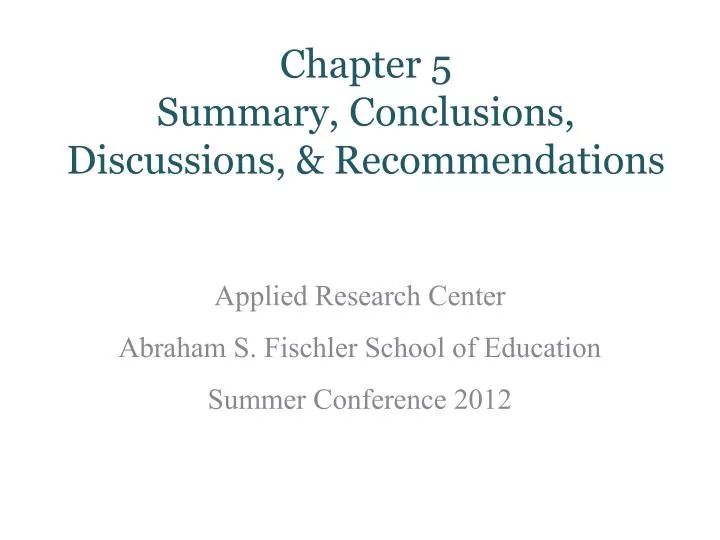

Chapter 5 Summary, Conclusions, Discussions, & Recommendations
Jul 29, 2014
2.15k likes | 7.16k Views
Chapter 5 Summary, Conclusions, Discussions, & Recommendations . Applied Research Center Abraham S. Fischler School of Education Summer Conference 2012. General Information. This session will address the components of Chapter 5 of the Applied Dissertation.
Share Presentation
- straightforward manner
- statistical jargon
- liberal statistics
- health promotion
- education summer conference

Presentation Transcript
Chapter 5 Summary, Conclusions, Discussions, & Recommendations Applied Research Center Abraham S. Fischler School of Education Summer Conference 2012
General Information This session will address the components of Chapter 5 of the Applied Dissertation. The format and style of Chapter 5 should follow the Style Guide for the Applied Dissertationand the sixth edition of the APA manual.
Chapter 5 Purpose of Chapter 5: To provide the readers with a thorough understanding of what the results of your study mean to the research field and to professional practice.
Chapter 5 Chapter 5 allows you to summarize the findings, discuss the importance of the findings, place the research findings in the context of current literature, compare and contrast the research findings with other relevant research, identify the strengths and weaknesses of the research study, discuss the implications of the research findings, and make recommendations for future research.
Summary of Findings Restate the results presented in Chapter 4 using little or no statistical jargon. Write in a clear straightforward manner with no interpretation of the results. Use past tense. Do not include tables and figures. Identify whether the findings of your study supported the hypotheses or research questions. Present unusual findings (e.g., results that you did not expect to be significant but were, and vice versa).
Interpretation of Findings Analyze both significant findings and not significant findings. Were the results what you predicted? Why do you think the results turned out the way they did? Were there any issues related to sampling, measurement, and procedural issues, as well as confounding variables? Provide possible explanations for the results. Link the results to any theoretical framework you used to develop your research question or hypotheses.
Context of Findings Place your findings in perspective to other studies of the topic found in the reviewed literature. How are your findings similar or different from those of other studies? Based on the literature, are the findings what might have been expected? If your results differ from those of other studies, what plausible explanations can account for this?
Implications of Findings • How do the findings expand the understanding of the phenomenon under study? • Identify the implications of the findings for • Theory: Are findings consistent with current theories in the field? Are they consistent with the selected theoretical framework for your study? • Research: Does the study help advance the research methodology in the field? (e.g., understanding of new confounding variables, issues of measurement, issues of design) • Practice: Who may be interested in using these findings in a professional field? Why should they pay attention to the findings? Could the findings lead to changes in the way professionals “do” things?
Discussion on Limitations Review the potential limitations that you initially proposed in the proposal. Discuss the limitations that may have affected—one way or another—your findings. Limitations typically originate in one of two sources: the study’s design and the study’s problems during implementation. Issues of design involve decisions about sampling, assessment, procedures, and choice of research design (poor match). Some of the issues that may have arisen at the time of research implementation relate to low sample size, measurement issues, heterogeneous groups, and so forth.
Discussion on Limitations (Cont.) Think of limitations in four major areas: Internal Validity—Unless the study is a “true experiment” one cannot claim that the IV “caused” changes in the DV. External Validity—Discuss the extent to which findings can be generalized. Measurement—Discuss issues of reliability and validity of assessment instruments. Statistical Analysis—Discuss issues of power, effect size, conservative or liberal statistics, and statistical test chosen.
Discussion on Future Directions Discuss findings in light of questions or issues that suggest future research directions. Extend the study to other populations. Think of other IVs and DVs that ought to be explored in the field; also, think of how to assess those additional variables. This is the section of the paper where most researchers are allowed to dream; think of extending your study to other questions that may add to the understanding of the issues.
Bibliography Cone, J. D., & Foster, S. F. (2006). Dissertations and theses from start to finish: Psychology and related fields. Washington, DC: American Psychological Association. Cottrell, R. R., & McKenzie, J. F. (2011). Health Promotion and education research methods: Using the five-chapter thesis/dissertation model (2nd ed.). Sudbury, MA: Jones and Bartlett.
- More by User

Technical Recommendations for Highways No 12 TRH 12
Technical Recommendations for Highways No 12 TRH 12. Technical Recommendations for Highways No 12 TRH 12. 1980 1983 – draft TRH 12: Bituminous pavement rehabilitation design 1983 1989 1990
1.32k views • 53 slides

Chapter 8. Producing Summary Reports. Section 8.1. Introduction to Summary Reports. Objectives. Identify the different report writing procedures. Create one-way and two-way frequency tables using the FREQ procedure. Restrict the variables processed by the FREQ procedure.
1.95k views • 158 slides
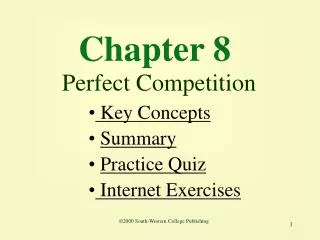
Chapter 8 Perfect Competition
Chapter 8 Perfect Competition. Key Concepts Summary Practice Quiz Internet Exercises. ©2000 South-Western College Publishing. In this chapter, you will learn to solve these economic puzzles:. Why is the demand curve horizontal for a firm in a perfectly competitive market?.
1.53k views • 95 slides
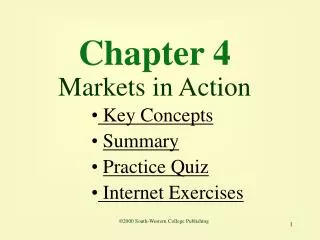
Chapter 4 Markets in Action
Chapter 4 Markets in Action. Key Concepts Summary Practice Quiz Internet Exercises. ©2000 South-Western College Publishing. In this chapter, you will learn to solve these economic puzzles:. How does the spotted owl affect the price of homes?.
1.18k views • 76 slides

Lec 3 Sept 2 complete Chapter 1 exercises from Chapter 1 quiz # 1 Chapter 2 st
Lec 3 Sept 2 complete Chapter 1 exercises from Chapter 1 quiz # 1 Chapter 2 start. Performance Summary. Performance depends on Algorithm: affects IC, possibly CPI Programming language: affects IC, CPI Compiler: affects IC, CPI
1.07k views • 28 slides
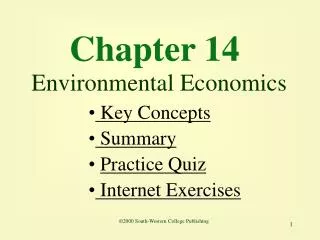
Chapter 14 Environmental Economics
Chapter 14 Environmental Economics. Key Concepts Summary Practice Quiz Internet Exercises. ©2000 South-Western College Publishing. In this chapter, you will learn to solve these economic puzzles:.
1.19k views • 77 slides
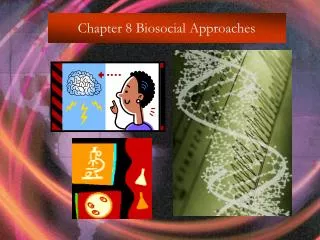
Chapter 8 Biosocial Approaches
Chapter 8 Biosocial Approaches. Chapter Summary. Chapter Eight discusses the importance of both genetic and hereditary influences on criminal behavior as well as the environmental interaction with those genetic & biological mechanisms.
1.09k views • 50 slides

The Word Is Alive 1 Corinthians
The Word Is Alive 1 Corinthians. Chapter Five Narrated by Tony Gillon. Chapter Five. Summary of Chapter Five This brief chapter deals with a specific instance of gross sexual immorality that Paul clearly states must be dealt with.
1.24k views • 102 slides

The Word Is Alive 1 John
The Word Is Alive 1 John. Chapter One Narrated by Tony Gillon. Chapter One. Summary of Chapter One The most eloquent introduction. Chapter One. Summary of Chapter One The most eloquent introduction. God is light. Chapter One. Summary of Chapter One The most eloquent introduction.
1.59k views • 143 slides

The Word Is Alive Galatians
The Word Is Alive Galatians. Chapter Three Narrated by Tony Gillon. Chapter Three. Summary of Chapter Three The theme of justification by faith alone continues. Chapter Three. Summary of Chapter Three The theme of justification by faith alone continues. The promise precedes the law.
2.28k views • 216 slides

The Word Is Alive The Book of Acts
The Word Is Alive The Book of Acts. Chapter Twelve Narrated by Tony Gillon. Chapter Twelve. Summary of Chapter Twelve The martyrdom of James Zebedee. Chapter Twelve. Summary of Chapter Twelve The martyrdom of James Zebedee. King Agrippa arrests Peter. Chapter Twelve.
1.67k views • 126 slides

The Word Is Alive The Gospel of Matthew
The Word Is Alive The Gospel of Matthew. Chapter Four Narrated by Tony Gillon. Chapter Four. Summary of Chapter Four Forty days of testing by the devil. Chapter Four. Summary of Chapter Four Forty days of testing by the devil. Jesus’ teaching ministry commences. Chapter Four.
2.14k views • 203 slides
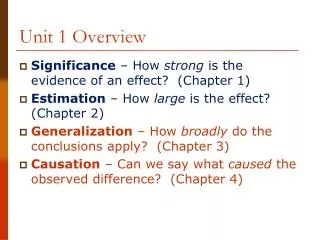
Unit 1 Overview
Unit 1 Overview. Significance – How strong is the evidence of an effect? (Chapter 1 ) Estimation – How large is the effect? (Chapter 2 ) Generalization – How broadly do the conclusions apply? (Chapter 3 ) Causation – Can we say what caused the observed difference? (Chapter 4).
1.22k views • 94 slides
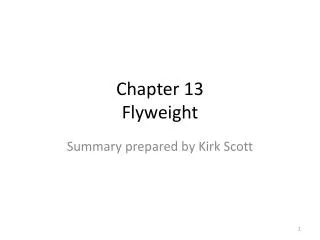
Chapter 13 Flyweight
Chapter 13 Flyweight. Summary prepared by Kirk Scott. Design Patterns in Java Chapter 13 Flyweight. Summary prepared by Kirk Scott. That animal is known as a couscous A trip to Wikipedia will allow you to determine whether it is related to the food named couscous…. Introduction.
1.33k views • 114 slides

The Word Is Alive 1 Timothy
The Word Is Alive 1 Timothy. Chapter Five Narrated by Tony Gillon. Chapter Five. Summary of Chapter Five The need to show respect in church. Chapter Five. Summary of Chapter Five The need to show respect in church. Honouring widows. Chapter Five. Summary of Chapter Five
2.08k views • 191 slides

Chapter 8: IP Addressing
Chapter 8: IP Addressing. Introduction to Networks. Chapter 8. 8 .0 Introduction 8.1 IPv4 Network Addresses 8 .2 IPv6 Network Addresses 8 .3 Connectivity Verification 8.4 Summary. IP Addressing Chapter 8: Objectives. In this chapter, you will be able to:
1.06k views • 88 slides

Audit Engagement Overview
Audit Engagement Overview. Plan. Perform. Communicate. Monitor. Research and apply Standards. Maintain fraud awareness. Assess risk. Collect, evaluate, analyze, interpret data. Report findings, conclusions, recommendations. Monitor engagement outcomes. Develop workpapers.
1.88k views • 69 slides

The Word Is Alive The Gospel of Luke
The Word Is Alive The Gospel of Luke. Chapter Twenty Four Presented by Tony Gillon. Chapter Twenty Four. Summary of Chapter Twenty Four The empty tomb. Chapter Twenty Four. Summary of Chapter Twenty Four The empty tomb. The Emmaus Road. Chapter Twenty Four.
2.4k views • 212 slides

The Word Is Alive 1 Timothy. Chapter Two Narrated by Tony Gillon. Chapter Two. Summary of Chapter Two The requirements for corporate worship. Chapter Two. Summary of Chapter Two The requirements for corporate worship Paul addresses the behaviour in gatherings. Chapter Two.
2.42k views • 225 slides
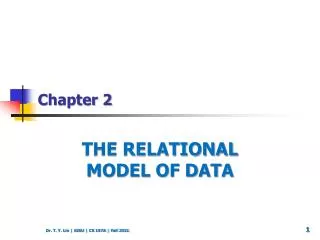
Chapter 2. THE RELATIONAL MODEL OF DATA. Chapter 2 The Relational Model of Data. 2.1 An Overview of Data Models 2.2 Basics of Relational Model 2.3 Defining a Relation Schema in SQL 2.4 An Algebraic Query Language 2.5 Constraints on Relations 2.6 Summary of Chapter 2
1.38k views • 105 slides

Electralink Customer Survey Presentation 3 rd December 2007
R. Electralink Customer Survey Presentation 3 rd December 2007. Presentation Coverage. Introduction Overview Quantitative Survey Results Focus On DTS Focus On SPAA Focus On DCUSA Qualitative Research Summary & Conclusions Recommendations For 2008 Research. R. Introduction.
1.3k views • 113 slides

Chapter 12. Advanced Genetics. 11.3 Section Summary 6.3 – pages 296 - 301. Mutations. Mutation: a change in __. May involve : an entire __ a specific __ may take place in __ cell.
1.01k views • 87 slides
Research Guide
Chapter 5 sections of a paper.
Now that you have identified your research question, have compiled the data you need, and have a clear argument and roadmap, it is time for you to write. In this Module, I will briefly explain how to develop different sections of your research paper. I devote a different chapter to the empirical section. Please take into account that these are guidelines to follow in the different section, but you need to adapt them to the specific context of your paper.
5.1 The Abstract
The abstract of a research paper contains the most critical aspects of the paper: your research question, the context (country/population/subjects and period) analyzed, the findings, and the main conclusion. You have about 250 characters to attract the attention of the readers. Many times (in fact, most of the time), readers will only read the abstract. You need to “sell” your argument and entice them to continue reading. Thus, abstracts require good and direct writing. Use journalistic style. Go straight to the point.
There are two ways in which an abstract can start:
By introducing what motivates the research question. This is relevant when some context may be needed. When there is ‘something superior’ motivating your project. Use this strategy with care, as you may confuse the reader who may have a hard time understanding your research question.
By introducing your research question. This is the best way to attract the attention of your readers, as they can understand the main objective of the paper from the beginning. When the question is clear and straightforward this is the best method to follow.
Regardless of the path you follow, make sure that the abstract only includes short sentences written in active voice and present tense. Remember: Readers are very impatient. They will only skim the papers. You should make it simple for readers to find all the necessary information.
5.2 The Introduction
The introduction represents the most important section of your research paper. Whereas your title and abstract guide the readers towards the paper, the introduction should convince them to stay and read the rest of it. This section represents your opportunity to state your research question and link it to the bigger issue (why does your research matter?), how will you respond it (your empirical methods and the theory behind), your findings, and your contribution to the literature on that issue.
I reviewed the “Introduction Formulas” guidelines by Keith Head , David Evans and Jessica B. Hoel and compiled their ideas in this document, based on what my I have seen is used in papers in political economy, and development economics.
This is not a set of rules, as papers may differ depending on the methods and specific characteristics of the field, but it can work as a guideline. An important takeaway is that the introduction will be the section that deserves most of the attention in your paper. You can write it first, but you need to go back to it as you make progress in the rest of teh paper. Keith Head puts it excellent by saying that this exercise (going back and forth) is mostly useful to remind you what are you doing in the paper and why.
5.2.1 Outline
What are the sections generally included in well-written introductions? According to the analysis of what different authors suggest, a well-written introduction includes the following sections:
- Hook: Motivation, puzzle. (1-2 paragraphs)
- Research Question: What is the paper doing? (1 paragraph)
- Antecedents: (optional) How your paper is linked to the bigger issue. Theory. (1-2 paragraphs)
- Empirical approach: Method X, country Y, dataset Z. (1-2 paragraphs)
- Detailed results: Don’t make the readers wait. (2-3 paragraphs)
- Mechanisms, robustness and limitations: (optional) Your results are valid and important (1 paragraph)
- Value added: Why is your paper important? How is it contributing to the field? (1-3 paragraphs)
- Roadmap A convention (1 paragraph)
Now, let’s describe the different sections with more detail.
5.2.1.1 1. The Hook
Your first paragraph(s) should attract the attention of the readers, showing them why your research topic is important. Some attributes here are:
- Big issue, specific angle: This is the big problem, here is this aspect of the problem (that your research tackles)
- Big puzzle: There is no single explanation of the problem (you will address that)
- Major policy implemented: Here is the issue and the policy implemented (you will test if if worked)
- Controversial debate: some argue X, others argue Y
5.2.1.2 2. Research Question
After the issue has been introduced, you need to clearly state your research question; tell the reader what does the paper researches. Some words that may work here are:
- I (We) focus on
- This paper asks whether
- In this paper,
- Given the gaps in knoweldge, this paper
- This paper investigates
5.2.1.3 3. Antecedents (Optional section)
I included this section as optional as it is not always included, but it may help to center the paper in the literature on the field.
However, an important warning needs to be placed here. Remember that the introduction is limited and you need to use it to highlight your work and not someone else’s. So, when the section is included, it is important to:
- Avoid discussing paper that are not part of the larger narrative that surrounds your work
- Use it to notice the gaps that exist in the current literature and that your paper is covering
In this section, you may also want to include a description of theoretical framework of your paper and/or a short description of a story example that frames your work.
5.2.1.4 4. Empirical Approach
One of the most important sections of the paper, particularly if you are trying to infer causality. Here, you need to explain how you are going to answer the research question you introduced earlier. This section of the introduction needs to be succint but clear and indicate your methodology, case selection, and the data used.
5.2.1.5 5. Overview of the Results
Let’s be honest. A large proportion of the readers will not go over the whole article. Readers need to understand what you’re doing, how and what did you obtain in the (brief) time they will allocate to read your paper (some eager readers may go back to some sections of the paper). So, you want to introduce your results early on (another reason you may want to go back to the introduction multiple times). Highlight the results that are more interesting and link them to the context.
According to David Evans , some authors prefer to alternate between the introduction of one of the empirical strategies, to those results, and then they introduce another empirical strategy and the results. This strategy may be useful if different empirical methodologies are used.
5.2.1.6 6. Mechanisms, Robustness and Limitations (Optional Section)
If you have some ideas about what drives your results (the mechanisms involved), you may want to indicate that here. Some of the current critiques towards economics (and probably social sciences in general) has been the strong focus on establishing causation, with little regard to the context surrounding this (if you want to hear more, there is this thread from Dani Rodrick ). Agency matters and if the paper can say something about this (sometimes this goes beyond our research), you should indicate it in the introduction.
You may also want to briefly indicate how your results are valid after trying different specifications or sources of data (this is called Robustness checks). But you also want to be honest about the limitations of your research. But here, do not diminish the importance of your project. After you indicate the limitations, finish the paragraph restating the importance of your findings.
5.2.1.7 7. Value Added
A very important section in the introduction, these paragraphs help readers (and reviewers) to show why is your work important. What are the specific contributions of your paper?
This section is different from section 3 in that it points out the detailed additions you are making to the field with your research. Both sections can be connected if that fits your paper, but it is quite important that you keep the focus on the contributions of your paper, even if you discuss some literature connected to it, but always with the focus of showing what your paper adds. References (literature review) should come after in the paper.
5.2.1.8 8. Roadmap
A convention for the papers, this section needs to be kept short and outline the organization of the paper. To make it more useful, you can highlight some details that might be important in certain sections. But you want to keep this section succint (most readers skip this paragraph altogether).
5.2.2 In summary
The introduction of your paper will play a huge role in defining the future of your paper. Do not waste this opportunity and use it as well as your North Star guiding your path throughout the rest of the paper.
5.3 Context (Literature Review)
Do you need a literature review section?
5.4 Conclusion
- Welcome to Chapter Five
Chapter 5 Webinars
- Alignment of Dissertation Components
- Dissertation Title Tips
- Proofreading Service in the ASC This link opens in a new window
- Dissertation Publishing: ProQuest
Jump to DSE Guide
Need help ask us.

- Next: Alignment of Dissertation Components >>
- Last Updated: Oct 30, 2024 5:45 PM
- URL: https://resources.nu.edu/c.php?g=1007181

© Copyright 2024 National University. All Rights Reserved.
Privacy Policy | Consumer Information

the ninth world
Research This: What Are the 5 Parts of a Research Paper?
Do you need to write a research paper to complete your high school coursework? Do you need help with identifying the different parts of an APA research paper?
Conducting research is a key step in widening your awareness and learning . It follows a scientific process, making it applicable to studies beyond educational institutions. It makes research and studies useful in all fields like business, public knowledge, and more.
Here, we’ll discuss the parts of a research paper, focusing on five key parts and their subparts. We also included some tips on how to write a good research paper. Continue below to learn more:
1. Parts of a Research Paper: The Problem and Its Background
When writing a research paper, the first thing to do is to present the problem you aim to address. Include the background of the study in this part. Discuss what drove you to conduct this research.
The background of the study also often serves as an introduction. After giving the context and purpose of your study, state the problem. Go back to this part of the research paper when writing the title and questionnaire.
The next slice of information to share is the significance of the study. What benefits does the study offer and who will it benefit? Later, when you write your recommendations, review this part.
Give the assumptions of the study. In short, think about the possible outcomes of your research. It’s a good way to communicate to the readers your desired results at the end of the research.
Next, define the scope and limitations of the study. You add more context to the study by determining its coverage. Finally, define the terms used in the study to help readers reach a deeper understanding.
2. Review of Related Literature
Once you have a background, context, and limits, present a review of the literature. It helps to avoid casting doubt on the impartiality of your study.
Among all the parts of a research paper (APA format), this section is one of the most exhausting. During this phase, you and your fellow researchers must read a lot. It’s draining if you’re not the type who likes reading but prefers experimentation.
Your goal is to look for evidence supporting or refuting your study. Provide organized data from related literature. Categorize them under various subheadings.
Keep in mind that this part is a combination of all studies. Avoid putting a simple list of individual summaries. Integrate the supporting data with your goals and expectations.
Other than summarization, paraphrase and write indirect speeches. Doing these practices help avoid plagiarizing others’ content. You must have the skill and good command of language and writing to accomplish this task.
3. Research Method and Procedures
Next in the parts of a research paper is to present the methods and procedures used in the research. Write down how you did the study as well as the research methods. Qualitative research is a good example.
Include the steps of a qualitative research procedure when writing your methods. The section must explain why the method was the best choice for the study.
Follow it with the subjects of the study. Your goal is to describe your respondents. Include important details such as who they are, their demographics, where they’re from, and more. Ensure that these details are relevant to further your study.
Put the details of the instruments used in the study under the right section. In most studies, the instrument is a questionnaire. After that, write your data-gathering procedures.
Once you have these down, discuss your statistical treatment strategy. Include your sampling method, formulas, and other treatments. If you find this part difficult, don’t hesitate to get research paper help from professionals.
4. Presentation, Analysis, and Interpretation of the Gathered Data
Fourth among the essential parts of a research paper is the presentation of all the gathered data. The most common strategy is to tabulate all the data from the questionnaires. Don’t forget to describe the results you found in your study.
If your study used both qualitative and quantitative tools, describe their separate results. Interpretations of the data must accompany the tables and descriptions. If you don’t include the interpretations of the data, your audience won’t know your tables’ meaning.
Before interpreting the gathered data, analyze it well. For example, you’re writing these parts of a historical research paper. Don’t stop at describing the type of procedures and/or software that you used.
You should also try to formulate a conclusion based on the data you gathered. This leads us to the next and final part of a research paper.
5. Summary, Conclusions, and Recommendations
Next, summarize the research paper, especially the data interpretations. Scan and reread the research paper to get a good idea of its contents. Keep the focus of the paper in mind.
In the conclusion, answer the earlier-stated problems. Here, you’ll prove or disprove your hypotheses and assumptions. Finally, include recommendations for further research, like focuses, actions, and other aspects.
Does writing a research paper seem exhausting or taxing? While it may seem that way for people who aren’t fond of writing or documenting their work, it’s essential. Students and even non-students can learn from writing research papers .
You learn how to gather and analyze data before making assumptions. Applying this in real life makes you a person with critical thinking skills. Research also promotes curiosity, the use of multiple sources, and better reading skills.
Create a Conducive and Comprehensive Research Paper Today
Those are the different parts of a research paper and their subparts. Now you know the necessary components of your research paper. Use these to guide your writing process and make informative content.
Are you looking to supplement your writing knowledge? For more educational content on research and related topics, see our other guides now.
More Stories

Quick Property Division Tips

THE AFTERMATH OF TAKING AN AVIATION TRAINING

Reasons to Choose a Career in Mechanical Engineering
You may have missed.

Attic Mold Remediation: What Homeowners Need to Know


How Much Does a Single Session Therapist Cost?

Strategies for Maintaining a Sustainable and Efficient Home

Unlock Exclusive Bonuses and Rewards in Online Betting

What If You Could Elevate Your Stay with a Penthouse? Here’s How
What are the 5 parts of the research paper

A regular research paper usually has five main parts, though the way it’s set up can change depending on what a specific assignment or academic journal wants. Here are the basic parts;
Introduction: This part gives an overview of what the research is about, states the problem or question being studied, and explains why the study is important. It often includes background info, context, and a quick look at the research to show why this study is needed.
Literature Review: In this part, the author looks at and summarizes existing research and writings on the chosen topic. This review helps spot gaps in what we already know and explains why a new study is necessary. It also sets up the theory and hypotheses for the research.
Methodology: The methodology section describes how the research was done – the plan, methods, and steps used to collect and analyze data. It should be detailed enough for others to repeat the study.
Results: This part shares what was found in the study based on the analyzed data. The results are often shown using tables, figures, and stats. It’s important to present the data accurately and without adding personal interpretations or discussions.
Discussion: Here, the results are explained in the context of the research question and existing literature. The discussion looks at what the findings mean, acknowledges any limits to the study, and suggests where future research could go. This is where the researcher can analyze, critique, and connect the results.
Besides these main sections, research papers usually have other parts like a title page, abstract, acknowledgments, and references. The structure might change a bit depending on the subject or type of research, but these five parts are generally found in academic research papers.
What is the structure of a research paper
A research paper usually follows a set format, including these parts:
Title Page: This page has the research paper’s title, the author’s name, where they’re affiliated (like a school), and often the date.
Abstract: The abstract is a short summary of the whole research paper. It quickly talks about the research question, methods, results, and conclusions. It’s usually limited to a specific number of words.
Introduction: This part introduces what the research is about. It states the main question, gives background info, and explains why the study is important. Often, it ends with a thesis statement or research hypothesis.
Literature Review: In this section, the author looks at and talks about other research and writings on the same topic. It helps to place the study in the context of what we already know, finding gaps, and explaining why this new research is needed.
Methodology: Here, the research plan is described. It explains how data was collected and analyzed, including details like who participated, what tools were used, and what statistical methods were applied. The goal is to provide enough info so others can do the same study.
Results: The results section shows what was found in the study based on the analyzed data. Tables, figures, and stats often help present the data. This part should be objective and report the results without personal interpretations.
Discussion: The discussion explains what the results mean in the context of the research question and existing literature. It looks at the implications of the findings, talks about any study limitations, and suggests where future research could go. This is where the author analyzes and connects the results.
Conclusion: The conclusion sums up the key findings of the study and stresses their importance. It might also suggest practical uses and areas for further investigation.
References (or Bibliography): This part lists all the sources cited in the paper, following a specific citation style like APA, MLA, or Chicago, as required by academic or publication guidelines.
Appendices: Extra materials, like raw data, questionnaires, or added info, can be put in the appendices.
Remember, the requirements for each section can vary based on the guidelines given by the instructor, school, or the journal where the paper might be published. Always check the specific requirements for the research paper you’re working on.
What are the 10 common parts of a research paper list in proper order
Here are the ten main parts of a research paper, listed in the right order:
Title Page: This page has the title of the research paper, the author’s name, where they’re affiliated (like a school), and the date.
Abstract: The abstract gives a short summary of the research, covering the main question, methods, results, and conclusions.
Introduction: This part introduces what the research is about. It states the main question, gives background info, and explains why the study is important.
Literature Review: In this section, the author looks at and talks about other research and writings on the same topic. It helps place the study in the context of what we already know and explains why this new research is needed.
Methodology: Here, the research plan is described. It explains how data was collected and analyzed, including details like who participated, what tools were used, and what statistical methods were applied.
Results: The results section shows what was found in the study based on the analyzed data. This part should be objective and report the results without personal interpretations.
Discussion: The discussion explains what the results mean in the context of the research question and existing literature. It looks at the implications of the findings, talks about any study limitations, and suggests where future research could go.
References (or Bibliography): This part lists all the sources cited in the paper, following a specific citation style as required by academic or publication guidelines.
Always check the specific requirements and guidelines given for the research paper you’re working on, as they can vary based on the instructor, school, or the journal where the paper might be published.
How long should a research paper be
The length of a research paper can vary a lot, depending on factors like the academic level, the type of research, and the specific instructions from the instructor or the target journal. Here are some general guidelines;
Undergraduate Level: Research papers at the undergraduate level, usually range from 10 to 20 pages, although this can change based on the requirements of the specific course.
Master’s Level: Master’s level research papers are generally longer, often falling between 20 to 40 pages. However, the length can vary depending on the subject and the program.
Ph.D. Level: Ph.D. dissertations or research papers are typically even longer, often going beyond 50 pages and sometimes reaching several hundred pages. The length is influenced by how deep and extensive the research is.
Journal Articles: For research papers meant for academic journal publication, the length is usually specified by the journal’s guidelines. In many cases, journal articles range from 5,000 to 8,000 words, but this can differ.
It’s really important to stick to the specific guidelines given by the instructor or the target journal. If there aren’t specific guidelines, think about how complex your research is and how in-depth your analysis needs to be to properly address the research question.
Also, some instructors might specify the length in terms of word count instead of pages. In these cases, the word count can vary, but a common range might be 2,000 to 5,000 words for undergraduate papers, 5,000 to 10,000 words for master’s level papers, and 10,000 words or more for Ph.D. dissertations.
What are 3 formatting guidelines from APA
The American Psychological Association (APA) has special rules for how to set up your research paper. Here are three important rules;
Title Page: Make a title page with the title of your paper, your name, and where you’re affiliated (like your school). Put the title in the middle, and your name and school below it in the middle too. In the top right corner, put a short version of the title and the page number.
In-Text Citations: When you mention a source in your paper, use the author’s last name and the year of publication in brackets. For example, if you talk about a book by Smith from 2020, you write (Smith, 2020). If you quote directly, add the page number too, like this: (Smith, 2020, p. 45).
References Page: Make a references page at the end listing all the sources you talked about in your paper. Arrange them alphabetically by the author’s last name. For books, use this format: Author, A. A. (Year of publication). Research Title: Capital letters also appear in the subheading. Publisher. For journal articles, it’s like this: Author, A. A. (Year of publication). Title of article. Title of Journal, volume number(issue number), page range. DOI or URL. Each entry should be indented right.
Remember, these are just a few important rules from APA. It’s crucial to check the official APA Publication Manual or the latest APA style guide for all the details and rules. Also, the rules might be a bit different for different types of sources, so pay attention to what APA says about each one.
What are the 4 major sections of a research paper
A research paper usually has four main parts;
Introduction: This part gets things started. It talks about what the research is about, gives some background info, and states the main question or idea. It’s important to show why the study matters.
Methods (or Methodology): The methods part explains how the research was done. It covers things like the plan, who took part, how data was collected, and how it was analyzed. The goal is to give enough detail so someone else could do the same study.
Results: The results section shows what was found in the research. It includes the raw data, stats, and any other info needed to answer the main question. It should be objective and focused on just reporting what happened, without adding personal thoughts.
Discussion: In the discussion part, the results are explained. It looks at what the findings mean in the context of the main question and other research. It talks about the impact of the results, mentions any study limits, and suggests where more research could go. This is where the researcher shares insights, makes conclusions, and talks about why the study is important.
Even though these four parts are common, the way they are set up can change. It depends on what the instructor, school, or journal wants. Always check the specific guidelines for the research paper you’re working on.
How do you write a reference page in APA format
In APA format, the reference page is super important in a research paper. It’s like a big list that shows all the sources mentioned in the paper. Here are the basic rules for making a reference page in APA format:
Heading: At the top, center the title “References” without making it bold, italicized, underlined, or using quotation marks.
Format for Entries: Each source follows a special format based on its type (like a book, journal article, or website).
For a book, the setup is
- Author, A. A. (Year of publication). Title of work: Capital letter also for subtitle. Publisher.
For a journal article, it’s
- Author, A. A. (Year of publication). Title of article. Title of Journal, volume number(issue number), page range. DOI or URL
Alphabetical Order: Organize the sources chronologically by the last name of the primary writer. If there’s no author, use the title for sorting, ignoring words like “A,” “An,” or “The.”
Hanging Indentation: Each entry has a hanging indentation. This means the first line starts on the left, and the following lines are indented by 0.5 inches.
Italicize Titles: Italicize the titles of bigger things like books and journals. For example: Title of the Book or Title of the Journal .
Use Proper Capitalization: Only capitalize the first word of the title, the first word after a colon in the subtitle, and any special names.
Remember these examples;
Book: Author, A. A. (Year of publication). Title of work: Capital letter also for subheading. Publisher.
Journal Article: Author, A. A. (Year of publication). Title of article. Title of Journal, volume number(issue number), page range. DOI or URL.
To make sure you get the latest information, check the APA rules.
What is the purpose of the Introduction section in a research paper
The Introduction section of a research paper serves several crucial purposes;
- Contextualization: It provides background information to help readers understand the broader context of the research. This may include the historical development of the topic, relevant theoretical frameworks, or existing gaps in knowledge.
- Problem Statement: The introduction outlines the specific problem or question that the research aims to address. It helps to articulate the gap in current knowledge or identify a need for further investigation.
- Justification and Significance: The section explains why the research is important and how it contributes to the existing body of knowledge. It highlights the potential impact and significance of the study.
- Objectives or Hypothesis: The introduction often states the research objectives or formulates a hypothesis, providing a clear roadmap for what the study aims to achieve or test.
- Scope and Limitations: It defines the boundaries of the research, outlining what the study includes and excludes. This helps readers understand the context within which the research findings should be interpreted.
- Research Questions: The introduction may pose specific questions that the research seeks to answer. These questions guide the reader in understanding the focus and purpose of the study.
- Overview of Methodology: While detailed methods are typically discussed in a separate section, the introduction may provide a brief overview of the research design, methods, and data collection techniques.
- Thesis Statement: In some cases, the introduction concludes with a concise thesis statement that encapsulates the main argument or purpose of the research paper.
Overall, the Introduction sets the stage for the research, engaging the reader’s interest, providing necessary context, and establishing the rationale for the study. It is a critical component that helps readers understand the importance of the research and motivates them to continue reading the paper.
How should the Literature Review be structured in a research paper
The structure of a literature review in a research paper typically follows a systematic and organized approach. Here’s a general guideline on how to structure a literature review;
Introduction
- Provide an overview of the topic and its significance.
- Clearly state the purpose of the literature review (e.g., identifying gaps, providing background).
- Mention the criteria used for including or excluding specific studies.
Organizing Themes or Categories
- Group relevant literature into themes or categories based on common themes, concepts, or methodologies.
- This could be chronological, thematic, methodological, or a combination, depending on the nature of the research.
Chronological Order
- If your topic has a historical development, consider presenting studies chronologically to show the evolution of ideas or research in the field.
Thematic Organization
- Group studies based on common themes, concepts, or theoretical frameworks. Each theme could represent a section in your literature review.
Methodological Approach
- Discuss studies based on their research methods. This can be particularly relevant if your research involves comparing or contrasting different methodologies.
Critical Analysis
- Critically evaluate each study, discussing its strengths and weaknesses.
- Identify patterns, inconsistencies, or gaps in the existing literature.
- Highlight the significance of each study to your research question or topic.
- Summarize the key findings and insights from each study.
- Discuss how the studies relate to one another and contribute to the overall understanding of the topic.
Gaps and Limitations
- Identify gaps in the literature and areas where further research is needed.
- Discuss the limitations of existing studies.
- Summarize the main points of the literature review.
- Emphasize the contribution of the literature review to your research.
- Provide a smooth transition to the next section of your research paper.
Remember to use clear and concise language throughout the literature review. Each section should flow logically, with a clear connection between paragraphs. Additionally, ensure that you cite all relevant studies and sources using the appropriate citation style (e.g., APA, MLA).
What information should be included in the Methodology section of a research paper
The Methodology section of a research paper provides a detailed description of the procedures and techniques used to conduct the study. It should offer sufficient information for other researchers to replicate the study and verify the results. Here’s a comprehensive guide on what information should be included in the Methodology section;
Research Design
- Specify the overall design of the study (e.g., experimental, observational, survey, case study).
- Justify why the chosen design is appropriate for addressing the research question.
Participants or Subjects
- Clearly describe the characteristics of the participants (e.g., demographics, sample size).
- Explain the criteria for participant selection and recruitment.
Sampling Procedure
- Detail the sampling method used (e.g., random sampling, stratified sampling).
- Provide information on how participants were recruited and consented.
- Identify and define the independent and dependent variables.
- Describe any control variables or confounding factors.
Instrumentation or Materials
- Specify the tools, instruments, or materials used to collect data (e.g., surveys, questionnaires, equipment).
- Include information on the reliability and validity of instruments, if applicable.
- Outline the step-by-step process of data collection.
- Include details on the experimental setup, if applicable.
- Describe any pre-testing, training, or pilot studies conducted.
Data Collection
- Explain how data were collected, including the timeframe.
- Detail any procedures to ensure data accuracy and reliability.
Data Analysis
- Specify the statistical or analytical methods used to analyze the data.
- Justify the choice of statistical tests or analytical tools.
Ethical Considerations
- Discuss any ethical issues and how they were addressed (e.g., informed consent, confidentiality, institutional review board approval).
- State whether the study followed ethical guidelines and standards.
Validity and Reliability
- Talk about the measures undertaken to guarantee the reliability and accuracy of the research.
- Provide information on any measures taken to control extraneous variables.
Limitations: Acknowledge any limitations of the study that may affect the generalizability of the results.
Statistical Significance: If applicable, report the criteria used for determining statistical significance.
The Methodology section should be written in a clear and concise manner, providing enough detail for others to replicate the study. Additionally, it is crucial to adhere to the guidelines of the chosen citation style (e.g., APA, MLA) when documenting sources and references related to the methodology.
Why is the Results section important in scientific research papers
The Results section in scientific research papers is critical for several reasons;
- Presentation of Findings: The Results section is where researchers present the outcomes of their study. It includes raw data, measurements, observations, and any other information gathered during the research process.
- Objectivity and Transparency: By providing raw data and statistical analyses, the Results section ensures transparency and objectivity. Other researchers should be able to review the data and draw their own conclusions.
- Verification and Replicability: Results allow other researchers to verify the study’s findings. Replicability is a fundamental principle in science, and a clear presentation of results facilitates the replication of experiments or studies by other researchers.
- Support or Refutation of Hypotheses: The Results section is where researchers can determine whether their findings support or refute their initial hypotheses. This is a crucial step in the scientific method and contributes to the accumulation of knowledge in a particular field.
- Basis for Discussion and Interpretation: The data presented in the Results section serve as the foundation for the subsequent Discussion section. Researchers interpret the results, discuss their implications, and relate them to existing literature. Without clear and accurate results, the discussion lacks a solid basis.
- Scientific Progress: Reporting results allows the scientific community to advance. Other researchers can build upon the findings, either by confirming or challenging them, which contributes to the overall progress of scientific knowledge.
- Peer Review Process: The Results section is a key component in the peer review process. Other experts in the field assess the validity and significance of the results before the paper is accepted for publication.
- Data Integrity and Research Ethics: By presenting the raw data, researchers demonstrate the integrity of their work. It also allows for scrutiny regarding research ethics, ensuring that data collection and analysis were conducted ethically and rigorously.
- Support for Funding and Grants: Clear and compelling results are often necessary when seeking funding or grants. Funding agencies and institutions need to see that the research is producing meaningful and impactful results.
- Communication of Findings to a Wider Audience: The Results section, along with other parts of the research paper, contributes to the communication of findings to a broader audience, including scientists, educators, policymakers, and the general public.
In summary, the Results section is crucial because it is the primary means through which researchers communicate their findings to the scientific community and beyond. It plays a central role in the scientific method by providing a platform for the objective presentation and interpretation of data, fostering transparency, verification, and further research.
How do you properly format and present tables and figures in the Results section of the research paper
Properly formatting and presenting tables and figures in the Results section is essential for conveying information clearly and effectively. Here are some guidelines to follow;
Title and Numbering
- Provide a clear and concise title for each table.
- Number tables sequentially (e.g., Table 1, Table 2).
Headings and Subheadings
- Use clear and descriptive column and row headings.
- If the table is large, consider using subheadings to organize the data.
Alignment and Consistency
- Align text consistently within columns (e.g., left-align text, center numeric data).
- Maintain consistency in formatting throughout the table.
- Include footnotes to explain abbreviations, symbols, or provide additional context.
- Use superscript numbers or symbols for footnotes and explain them below the table.
Units of Measurement
- Clearly specify units of measurement for numerical data.
- Place units in the column or row headings or provide a separate row for units.
Formatting Numbers
- Use consistent decimal places and significant figures.
- Consider rounding numbers appropriately for clarity.
Empty Cells
- Avoid leaving empty cells; use dashes or other symbols to indicate missing data.
- Clearly state if a value is not applicable.
Reference in Text
- Reference each table in the text and briefly discuss key findings.
- Use the table number in parentheses (e.g., (Table 1)).
Caption and Numbering
- Provide a descriptive caption for each figure.
- Number figures sequentially (e.g., Figure 1, Figure 2).
Clarity of Graphics
- Ensure that the graphic is clear, legible, and appropriately sized.
- Use high-resolution images or create easily interpretable graphs.
Axes and Labels
- Clearly label all axes with the appropriate units.
- Use descriptive axis labels that convey the nature of the data.
- Include a legend if the figure includes different elements (e.g., lines, symbols).
- Ensure the legend is placed in a way that does not obscure the data.
Color and Contrast
- Use color strategically, considering accessibility for readers with color vision deficiencies.
- Ensure sufficient contrast for all elements in black-and-white printing.
Annotations
- If necessary, add annotations to highlight specific points or trends.
- Use arrows, labels, or other indicators for emphasis.
Consistent Style
- Maintain a consistent style across multiple figures within the same paper.
- Use similar fonts, colors, and scales for a cohesive presentation.
- Reference each figure in the text and briefly discuss key findings.
- Use the figure number in parentheses (e.g., (Figure 1)).
Remember, clarity and consistency are key. Ensure that tables and figures are easy to understand without the need for additional explanation. Additionally, follow the formatting guidelines of the specific journal or publication you are submitting to, as they may have specific requirements for tables and figures.
What is the significance of the Discussion section in a research paper
The Discussion section in a research paper holds significant importance as it allows researchers to interpret their findings, relate them to existing knowledge, and draw meaningful conclusions. Here are several key aspects highlighting the significance of the Discussion section;
- Interpretation of Results: The Discussion section provides an opportunity to explain and interpret the results obtained in the study. Researchers can clarify the meaning of their findings and elaborate on their implications.
- Comparison with Previous Research: Researchers can compare their results with existing literature to highlight similarities, differences, or advancements in knowledge. This contributes to the ongoing dialogue within the scientific community.
- Addressing Research Questions or Hypotheses: The Discussion section allows researchers to address the initial research questions or hypotheses stated in the introduction. They can evaluate whether their findings support or refute the proposed hypotheses.
- Contextualizing Results: Researchers can place their results in the broader context of the field. This involves discussing how the study contributes to existing knowledge and understanding, emphasizing its significance.
- Identification of Patterns and Trends: Patterns and trends observed in the data can be explored and explained in the Discussion section. Researchers can discuss the reasons behind these patterns and their implications for the research question.
- Limitations and Potential Biases: Acknowledging the limitations of the study is crucial in the Discussion section. Researchers can openly discuss any constraints, biases, or methodological issues that may have affected the results.
- Alternative Explanations: Researchers should consider alternative explanations for their findings and discuss why these alternatives were ruled out or how they might impact the interpretation of the results.
- Implications for Future Research: The Discussion section often includes suggestions for future research directions. Researchers can propose areas that need further exploration or recommend modifications to the study design for more robust investigations.
- Practical and Theoretical Implications: Researchers can discuss the practical implications of their findings, addressing how the results may be applied in real-world situations. They can also explore the theoretical implications, contributing to the development or refinement of theoretical frameworks.
- Synthesis of Key Points: The Discussion section serves as a synthesis of the key points of the paper, bringing together the results and their interpretation. It offers a cohesive and comprehensive understanding of the study’s outcomes.
- Contributions to the Field: Researchers can articulate the unique contributions of their study to the field. This is important for demonstrating the value of the research within the broader scholarly context.
In essence, the Discussion section is where researchers engage in a thoughtful and critical analysis of their results, connecting them to the wider body of knowledge and providing insights that go beyond the raw data presented in the Results section. It is a crucial component that adds depth and context to the research paper, allowing readers to fully grasp the implications and significance of the study.
What elements should be included in the Conclusion of a research paper
The Conclusion section of a research paper serves to summarize the main findings, restate the significance of the study, and offer insights derived from the research. Here are the key elements that should be included in the Conclusion;
Summary of Key Findings
- Provide a concise recap of the main results obtained in the study.
- Highlight the most important and relevant findings that address the research question or hypothesis.
Restatement of Research Objectives or Hypotheses
- Remind the reader of the initial research objectives or hypotheses stated in the introduction.
- Discuss how the findings either support or challenge these objectives.
Significance of the Study
- Reinforce the importance and relevance of the research within the broader context of the field.
- Clearly articulate the contribution of the study to existing knowledge and its potential impact.
Implications for Practice
- Discuss any practical implications of the findings for real-world applications.
- Address how the results may inform decision-making or practices in relevant areas.
Implications for Future Research
- Suggest areas for further exploration and research based on the limitations or gaps identified in the current study.
- Provide recommendations for researchers interested in building on the current findings.
Integration with Existing Literature
- Connect the study’s results with existing literature and research in the field.
- Discuss how the findings either align with or challenge previous studies.
Limitations and Caveats
- Acknowledge and discuss the limitations of the study.
- Provide a balanced assessment of the study’s constraints and potential sources of bias.
Reflection on Methodology
- Reflect on the appropriateness and effectiveness of the research methodology.
- Discuss any challenges encountered during the research process and how they may have influenced the results.
Conclusion Statement
- Offer a conclusive statement summarizing the overall implications of the study.
- Clearly state the main takeaway or message that readers should derive from the research.
Closing Thoughts
- Conclude with any final thoughts, reflections, or remarks that enhance the overall understanding of the research.
- Consider leaving the reader with a thought-provoking statement or a call to action related to the study’s findings.
Avoid New Information: The conclusion is not the place to introduce new information or data. It should focus on summarizing and synthesizing existing content.
Brevity and Clarity
- Keep the conclusion concise while ensuring clarity and coherence.
- Use straightforward language to communicate key points without unnecessary complexity.
So, the Conclusion section is the final opportunity to leave a lasting impression on the reader. It should effectively wrap up the research paper by summarizing the key elements and providing a sense of closure while encouraging further consideration of the study’s implications.
How do you write an effective Abstract that summarizes the key aspects of the research
Writing an effective abstract is crucial as it serves as a concise summary of your research, providing readers with a quick overview of the study’s key aspects. Here are some guidelines to help you write an impactful abstract;
- Understand the Purpose: Recognize that the abstract is a standalone summary of your research, and readers may use it to decide whether to read the full paper. It should convey the main points and significance of your study.
- Follow Structure Guidelines: Different journals and disciplines may have specific guidelines for abstracts. Ensure that you are aware of any required structure or word limit set by the journal or conference you are submitting to.
- Start with a Clear Context: Begin your abstract by providing a brief context for your research. Clearly state the background or problem that your study addresses.
- State the Research Question or Objective: Clearly articulate the research question, objective, or hypothesis that your study aims to address. Be concise but informative.
- Describe the Methods: Briefly outline the research methods used in your study. Include key details such as study design, participants, materials, and procedures.
- Present Key Results: Summarize the main findings of your research. Highlight the most important and relevant results that answer your research question.
- Include Quantitative Information: If applicable, provide quantitative information such as effect sizes, statistical significance, or numerical data that convey the magnitude and importance of the results.
- Convey Interpretation and Significance: Interpret the results briefly and discuss their significance. Explain how your findings contribute to the existing body of knowledge in the field.
- Highlight Key Conclusions: Clearly state the conclusions drawn from your study. This is not the place for introducing new information; rather, it’s a summary of the primary outcomes.
- Avoid Abbreviations and Jargon: Keep the abstract accessible to a broad audience by avoiding unnecessary abbreviations or discipline-specific jargon. Use language that can be easily understood by readers from diverse backgrounds.
- Be Concise and Specific: Strive for brevity while ensuring that you cover all essential aspects of your research. Use specific and precise language to convey your points.
- Check for Clarity and Coherence: Ensure that the abstract flows logically and that each sentence contributes to the overall understanding of your research. Check for clarity and coherence in your writing.
- Keywords: Include relevant keywords in your abstract. These terms should capture the essential topics of your research and aid in the discoverability of your paper in databases and search engines.
- Proofread Carefully: Eliminate grammatical errors, typos, or any unclear language. A well-written abstract demonstrates attention to detail and professionalism.
- Meet Word Limit Requirements: If there is a word limit, adhere to it. Concision is crucial in abstract writing, and exceeding the word limit may result in important information being omitted.
- Review and Revise: Once you have drafted your abstract, review it critically. Ask yourself if it effectively conveys the main points of your research and if it would pique the interest of potential readers.
The abstract is often the first (and sometimes only) part of your research paper that readers will see. Therefore, crafting a clear, concise, and compelling abstract is essential for drawing attention to your work and encouraging further exploration.
What is the difference between the Abstract and the Executive Summary in a research paper
The abstract and the executive summary serve similar purposes in providing a concise overview of a document, but they are typically used in different contexts and for different types of documents. Here are the key differences between an abstract and an executive summary;
Usage: Commonly used in academic and scholarly writing, such as research papers, articles, and conference presentations.
- Summarizes the entire research paper, including background, methodology, results, and conclusions.
- Generally includes information about the research question, methods, key findings, and implications.
- Primarily aimed at an academic audience, including researchers, scholars, and students.
- Serves as a standalone summary for individuals seeking a quick understanding of the research without reading the entire paper.
Length: Typically limited to a specific word count or length, often ranging from 150 to 250 words for academic papers.
Keywords: May include keywords that highlight the main topics of the research for indexing and search purposes.
Location: Positioned at the beginning of the research paper, providing readers with a preview of the study.
Executive Summary
Usage: More commonly found in business and professional documents, such as business plans, proposals, and reports.
- Summarizes the key points of a longer document, focusing on the most critical information for decision-makers.
- Often includes an overview of the purpose, methodology, major findings, recommendations, and potential actions.
- Intended for a business or managerial audience, including executives, stakeholders, or decision-makers.
- Aids busy professionals in quickly grasping the main points of a document without delving into the details.
Length: Can vary in length but is generally longer than an abstract, often spanning a page or more.
Keywords: May not always include specific keywords for indexing, as the primary focus is on communicating essential information to decision-makers.
Location: Typically placed at the beginning of a business document, allowing executives to quickly understand the document’s purpose and key recommendations.
In summary, while both the abstract and the executive summary serve the purpose of providing a brief overview, they are tailored to different audiences and contexts. The abstract is more common in academic settings, summarizing research papers, while the executive summary is often used in business and professional documents to distill key information for decision-makers.
How should citations and references be formatted in the References or Bibliography section
The formatting of citations and references in the References or Bibliography section of a research paper depends on the citation style specified by the journal, publication, or academic institution. Different disciplines and publications may have preferences for specific citation styles, such as APA (American Psychological Association), MLA (Modern Language Association), Chicago, Harvard, or others.
Here are general guidelines for formatting citations and references in common citation styles;
- Book: Author, A. A. (Year of publication). Title of work: C apital letters also appear in the subtitle. Publisher.
- Journal Article: Author, A. A. (Year of publication). Title of article. Title of Journal, volume number (issue number), page range. DOI or URL
- Webpage: Author, A. A. (Year, Month Day of publication). Title of webpage. Website Name. URL
- Book: Author’s Last Name, First Name. Title of Book . Publisher, Publication Year.
- Journal Article: Author’s Last Name, First Name. “Title of Article.” Title of Journal , vol. number, no. number, Year, pages. Database name or URL.
- Webpage: Author’s Last Name, First Name. “Title of Webpage.” Website Name, publication date, URL.
Chicago Style
- Book: Author’s First Name Last Name. Title of Book . Place of publication: Publisher, Year.
- Journal Article: Author’s First Name Last Name. “Title of Article.” Title of Journal vol. number, no. number (Year): pages.
- Webpage: Author’s First Name Last Name. “Title of Webpage.” Name of Website. URL
Harvard Style
- Book: Author’s Last Name, First Initial(s). (Year) Title of Book . Place of publication: Publisher.
- Journal Article: Author’s Last Name, First Initial(s). (Year) ‘Title of Article.’ Title of Journal , Volume number (Issue number), Page range.
- Webpage: Author’s Last Name, First Initial(s). (Year) ‘Title of Webpage.’ Available at: URL (Accessed: Day Month Year).
Always check the specific guidelines provided by the journal or publication you are submitting to, as they may have variations or preferences within a particular citation style. Additionally, consider using citation management tools like Zotero, EndNote, or Mendeley to streamline the citation process and ensure accuracy.
What is the role of the Acknowledgments section in a research paper
The Acknowledgments section in a research paper serves the purpose of expressing gratitude and recognizing individuals, institutions, or organizations that contributed to the research or the development of the paper. It is a way for the authors to acknowledge the support, assistance, and resources they received during the research process. Here are the key roles of the Acknowledgments section;
- Recognition of Contributions: The Acknowledgments section provides an opportunity for authors to acknowledge the contributions of individuals who directly or indirectly supported the research. This can include colleagues, mentors, advisors, and peers.
- Expression of Gratitude: Authors use this section to express gratitude for any assistance, guidance, or resources received. It is a way to show appreciation for the collaborative and supportive efforts of others.
- Mentioning Funding Sources: If the research was funded by grants or scholarships, authors typically acknowledge the funding sources in this section. This includes government agencies, private foundations, or other organizations that provided financial support.
- Recognition of Technical Assistance: Authors may acknowledge individuals or organizations that provided technical assistance, such as help with data analysis, laboratory techniques, or specialized equipment.
- Acknowledging Institutional Support: Authors may express gratitude to their affiliated institutions for providing facilities, libraries, or other resources that facilitated the research.
- Thanking Reviewers or Editors: In some cases, authors express appreciation for the feedback and constructive criticism received from peer reviewers during the publication process. This acknowledgment is often included in the Acknowledgments or sometimes in the opening of the paper.
- Acknowledging Personal Support: Authors may use this section to acknowledge personal support from family members, friends, or anyone who has supported them during the research process.
- Maintaining Professional Courtesy: Including an Acknowledgments section is also a matter of professional courtesy. It recognizes the collaborative and communal nature of research and emphasizes the importance of acknowledging those who contributed to the work.
- Ethical Considerations: The Acknowledgments section can also serve as a platform for authors to clarify any potential conflicts of interest or ethical considerations related to the research.
- Humanizing the Research Process: By acknowledging the human aspects of the research journey, the Acknowledgments section adds a personal touch to the paper, making it more relatable and emphasizing the collective effort involved in scholarly work.
It’s essential to strike a balance in the Acknowledgments section, being specific and genuine in expressing gratitude without making it overly lengthy. While it is a place to acknowledge various forms of support, it should remain focused on those contributions that directly impacted the research and its successful completion.
How do you determine the appropriate length for each section of a research paper
Determining the appropriate length for each section of a research paper involves considering several factors, including the type of paper, the guidelines provided by the target journal or publication, and the complexity of the research. While there are no fixed rules, the following general principles can help guide you;
- Follow Journal Guidelines: Journals often provide specific guidelines on the preferred structure and length of each section. Always refer to the submission guidelines of the target journal to ensure that your paper adheres to their requirements.
- Consider the Type of Paper: The length of each section can vary based on the type of paper. For example, a review article may have a more extensive literature review section compared to an original research paper. Understand the conventions for the type of paper you are writing.
- Adhere to Standard Structures: Research papers typically follow standard structures such as Introduction, Literature Review, Methodology, Results, Discussion, and Conclusion. While the length of each section may vary, maintaining a coherent structure is important for readability and understanding.
- Prioritize Key Information: Focus on presenting key information in each section. Avoid unnecessary details and ensure that the content is relevant to the research question or objective.
- Consider the Significance of Sections: Sections like the Methods and Results, which present the core of your research, may require more detailed explanations. The Introduction and Conclusion, while important, may be more concise.
- Balance and Proportion: Aim for a balanced distribution of content across sections. Avoid overemphasizing one section at the expense of others. Each section should contribute meaningfully to the overall narrative.
- Review Similar Publications: Examine research papers published in the target journal or similar venues. Analyze the length of sections in these papers to get a sense of the expectations for your own paper.
- Be Mindful of Word Limits: Some journals or conferences set word limits for articles. Be aware of these limits and allocate space accordingly. If there is a word limit, prioritize clarity and conciseness.
- Consider Reader Engagement: Readers appreciate a clear and well-structured paper. Aim for sections that are informative without being overly detailed. Engage your readers and maintain their interest throughout the paper.
- Revise and Edit: After drafting your paper, review and edit each section critically. Remove redundancies, unnecessary details, or content that does not directly contribute to the main message of each section.
- Seek Feedback: Obtain feedback from peers, colleagues, or mentors. Others' perspectives can help identify areas where content could be expanded or condensed.
Note that the appropriate length for each section can vary based on the specific requirements of your research and the expectations of the target audience. Strive for clarity, coherence, and relevance in each section to ensure that your research paper effectively communicates its purpose and findings.
Should the title of a research paper be included in the Abstract
Yes, the title of a research paper is typically included in the abstract. The abstract serves as a concise summary of the entire research paper, providing readers with an overview of the study’s purpose, methods, results, and conclusions. Including the title in the abstract helps readers immediately identify the topic and focus of the research.
The standard structure of an abstract often includes the following elements;
- Title: The title of the research paper is usually presented at the top of the abstract. It is written in the same way it appears in the full paper.
- Introduction or Background: A brief statement that introduces the research question or problem addressed in the study.
- Methods: A summary of the research methods employed, including the study design, participants, materials, and procedures.
- Results: A concise presentation of the key findings of the study.
- Conclusion or Implications: A discussion of the study’s conclusions, implications, or potential applications.
While the abstract aims to be succinct, it should still provide enough information for readers to understand the main components and contributions of the research. The inclusion of the title ensures that readers can quickly identify the specific topic of interest and decide whether the paper aligns with their interests or research needs.
What are the key components of the Introduction, Methods, Results, and Discussion (IMRAD) structure
The IMRAD structure is a commonly used format in scientific and academic writing, organizing research papers into distinct sections: Introduction, Methods, Results, and Discussion. Each section serves a specific purpose in presenting and communicating the research. Here are the key components of each section;
The Introduction section of a research paper typically includes the following components:
Background or Context
- Provides a brief overview of the research area, establishing the context for the study.
- Identifies the gap or problem in existing knowledge that the research aims to address.
Research Question or Hypothesis
- Clearly states the main research question or hypothesis that the study seeks to answer.
- Provides focus and direction for the research.
Objectives or Aims
- Outlines the specific objectives or aims of the study, detailing what the research intends to achieve.
- Explains the importance of the research and its potential contributions to the field.
- Highlights the relevance of addressing the identified gap or problem.
Review of Literature
- Summarizes relevant literature and previous studies related to the research topic.
- Provides the theoretical framework and context for the study.
The Methods section details the research design, participants, materials, and procedures used in the study;
Study Design
- Describes the overall design of the research (e.g., experimental, observational, survey).
- Justifies why the chosen design is appropriate for addressing the research question.
- Provides information about the participants or subjects involved in the study.
- Describes the criteria for participant selection and recruitment.
- Explains the method used for sampling and participant recruitment.
- Details how the sample represents the target population.
- Identifies and defines the independent and dependent variables.
- Describes any control variables or confounding factors.
- Specifies the tools, instruments, or materials used for data collection.
- Includes information on the reliability and validity of instruments.
- Outlines the step-by-step process of data collection.
- Includes any steps taken to ensure data accuracy and reliability.
The Results section presents the raw data and findings of the study:
Data Presentation
- Displays the gathered information in a structured and straightforward way.
- Utilizes tables, figures, and graphs to enhance data visualization.
Statistical Analyses
- Describes the statistical methods used to analyze the data.
- Presents statistical results, including significance levels.
Key Findings
- Summarizes the main findings of the study.
- Highlights any patterns, trends, or significant outcomes.
The Discussion section interprets the results, relates them to existing literature, and discusses their implications:
Interpretation of Results
- Offers a detailed interpretation of the study’s findings.
- Discusses how the results address the research question or hypothesis.
Comparison with Previous Research
- Compares the current findings with previous studies in the field.
- Discusses similarities, differences, or advancements in knowledge.
Limitations
- Acknowledges any limitations or constraints of the study.
- Addresses potential sources of bias or error.
Implications
- Discusses the broader implications of the findings.
- Explores the practical, theoretical, or policy implications.
Recommendations for Future Research
- Suggests directions for future research based on the study’s limitations or gaps identified.
- Provides guidance for researchers interested in building on the current findings.
The IMRAD structure is widely used because it provides a logical and organized framework for presenting research in a clear and systematic manner. Following this structure helps readers navigate the paper easily and understand the research process and outcomes.
How do you choose appropriate keywords for a research paper
Selecting appropriate keywords for a research paper is essential for enhancing the paper’s discoverability in databases and search engines. Here are steps to help you choose effective keywords;
- Identify Key Concepts: Identify the main concepts and topics addressed in your research. These concepts should represent the core elements of your study.
- Use Specific Terms: Choose keywords that are specific and closely related to your research. Avoid overly broad terms that may result in irrelevant search results.
- Consider Synonyms and Variations: Think about synonyms, alternative terms, and variations of your key concepts. Different researchers and databases may use different terminology.
- Include Related Terms: Consider terms that are closely related to your main concepts. This can include broader or narrower terms, related disciplines, or alternative phrasing.
- Review Existing Literature: Look at relevant articles and papers in your field. Identify the keywords used in these papers, as they may be suitable for your own research.
- Check Subject Headings: Explore the use of standardized subject headings or controlled vocabulary in the specific database or catalog you are using. These terms can help improve precision.
- Use Thesauruses and Databases: Consult thesauruses or controlled vocabulary lists provided by databases like PubMed, ERIC, or PsycINFO. These tools can suggest standardized terms used in the literature.
- Think About Variations in Language: Consider variations in language and spelling that may be used by researchers or authors in different regions or fields.
- Include Acronyms and Abbreviations: If applicable, include acronyms or abbreviations commonly used in your field. This ensures that researchers using these terms can find your paper.
- Be Mindful of Trends: Stay informed about emerging trends and terminology in your field. Include keywords that reflect the current discourse.
- Use a Mix of Broad and Specific Terms: Include a mix of broad and specific terms to cater to different levels of search specificity.
- Think About Alternative Spellings: Consider alternative spellings, particularly if certain terms may have multiple accepted spellings.
- Use Keywords Consistently: Ensure consistency in the use of keywords throughout your paper, including the title, abstract, and body. This helps search engines and databases index your paper accurately.
- Test and Refine: Test the effectiveness of your chosen keywords by conducting searches in relevant databases. If the results are too broad or narrow, adjust your keywords accordingly.
- Include Geographic and Temporal Keywords: If relevant, include keywords related to geographic locations or time periods. This can be important for studies with a regional or historical focus.
Collaborate and Seek Feedback: Discuss your chosen keywords with colleagues or mentors. They may offer valuable insights and suggestions.
Remember that the goal is to use keywords that accurately represent your research and align with the terminology used by others in your field. Using a combination of precise, specific terms and broader, related concepts ensures that your paper reaches a diverse audience interested in your research area.
When is it necessary to include a supplementary materials section in a research paper
A Supplementary Materials section in a research paper is included when there is additional information or content that is important for a comprehensive understanding of the research but is too extensive or detailed to be included in the main body of the paper. Here are situations when it is necessary or advisable to include a Supplementary Materials section;
- Extensive Data Sets: When the dataset or raw data is extensive and detailed, it may be included as supplementary materials. This allows interested readers or researchers to access and analyze the data more thoroughly.
- Complex Methodology Details: If the methodology used in the study is complex and detailed, providing additional explanations, schematics, or step-by-step procedures in the Supplementary Materials section can enhance clarity without overwhelming the main text.
- Additional Figures and Tables: If there are numerous figures, tables, or other graphical elements that contribute to the study but may interrupt the flow of the main text, they can be placed in the Supplementary Materials.
- Extended Literature Reviews: In cases where the literature review is extensive but not directly tied to the main narrative, an extended literature review or additional references can be placed in the Supplementary Materials.
- Code and Algorithms: For studies involving computer code, algorithms, or detailed mathematical proofs, including these in the Supplementary Materials allows readers interested in the technical details to access and review them.
- Participant Details or Additional Experiments: If there are extensive details about participants (e.g., demographics, characteristics) or additional experiments that are relevant but not critical to the main argument, they can be included in the Supplementary Materials.
- Supporting Information for Analyses: Supporting information for statistical analyses, sensitivity analyses, or robustness checks can be included in the Supplementary Materials.
- Audio-Visual Material: For studies involving audio-visual material (e.g., sound clips, video recordings), the Supplementary Materials section is an appropriate place to include these additional resources.
- Appendices: Appendices that contain supplementary information, such as questionnaires, interview transcripts, or additional results, can be placed in the Supplementary Materials.
- Ethical Approvals and Permissions: Copies of ethical approvals, permissions, or other documentation that may be required but are not integral to the main narrative can be included in the Supplementary Materials.
- Supplementary Text: Additional explanations, derivations, or details that provide depth but might disrupt the main flow of the paper can be included in the Supplementary Materials.
- Additional Results or Analyses: If there are secondary or exploratory analyses that are interesting but not crucial to the primary findings, they can be presented in the Supplementary Materials.
In general, the Supplementary Materials section is a flexible space that allows authors to include content that supports the main argument without overwhelming the main text. However, it’s crucial to ensure that the main paper remains coherent and self-contained, with the Supplementary Materials serving as supplementary, rather than essential, information. Authors should always check the specific guidelines of the journal they are submitting to regarding the inclusion of supplementary materials.
What is the difference between a research paper and a review article, and how does it affect the structure
A research paper and a review article serve different purposes in academic writing, and they differ in terms of their objectives, content, and structure.
Research Paper
Purpose: Objective Research Contribution: A research paper presents the findings of original research or experimentation. It aims to contribute new knowledge to a specific field or address a research question or hypothesis.
Content: Empirical Data: Research papers typically include detailed descriptions of the study’s methodology, data collection, and analysis. They present empirical data and discuss the implications of the results.
Structure: IMRAD Structure: Research papers often follow the IMRAD structure (Introduction, Methods, Results, and Discussion), providing a systematic and organized presentation of the research process and outcomes.
Citations: Primary Literature: Citations primarily include references to the original research, emphasizing the direct sources of data and information.
Audience: Specialized Audience: Research papers are often written for a specialized audience, such as researchers, scholars, and professionals in the specific field of study.
Review Article
Purpose: Synthesis of Existing Literature: A review article aims to summarize, evaluate, and synthesize existing literature on a specific topic. It provides an overview of the current state of knowledge in a particular area.
Content: Analysis and Evaluation: Review articles analyze and evaluate the findings of multiple studies, offering a comprehensive perspective on the topic. They may include historical context, theoretical frameworks, and discussions of trends.
Structure: Varied Structure: Review articles may have a more flexible structure compared to research papers. While they often include an introduction and conclusion, the body of the article may be organized thematically, chronologically, or by methodological approach.
Citations: Secondary Literature: Citations in a review article primarily refer to existing literature, summarizing and citing multiple sources to provide a comprehensive overview.
Audience: Wider Audience: Review articles are often written to appeal to a broader audience, including students, researchers, and professionals seeking a comprehensive understanding of a specific topic.
Structural Differences
- Introduction: In a research paper, the introduction clearly defines the research question or hypothesis. In a review article, the introduction provides context for the broader topic, explaining why the review is important.
- Methods and Results: Research papers include detailed sections on methods and results, describing the study design, data collection, and findings. Review articles do not typically have dedicated sections for methods and results but may include methodological considerations in the text.
- Discussion: In a research paper, the discussion interprets the study’s results and discusses their implications. In a review article, the discussion synthesizes and interprets the findings from multiple studies, offering insights and identifying gaps in the existing literature.
- Conclusion: The conclusion of a research paper summarizes the study’s main findings and their significance. In a review article, the conclusion often emphasizes the key themes, trends, or unresolved questions in the field.
While these distinctions are general, it’s important to note that the specific structure and requirements can vary based on the guidelines of the target journal or publication. Authors should always refer to the submission guidelines when preparing a research paper or a review article.
How do you write an effective thesis statement in the Introduction section
An effective thesis statement in the introduction serves as a concise and clear summary of the main point or claim of your research paper. It provides direction to the reader, outlining the purpose and focus of your study. Here are some guidelines on how to write an effective thesis statement in the introduction;
- Clarity and Conciseness: Ensure that your thesis statement is clear, concise, and directly addresses the main point of your paper. Avoid vague or ambiguous language.
- Specificity: Be specific about the topic or issue you are addressing. Clearly state the aspect of the subject that your paper will focus on.
- One Main Idea: A thesis statement should convey one main idea or argument. Avoid trying to cover too many topics or issues in a single thesis statement.
- Declarative Statement: Formulate your thesis as a declarative statement rather than a question. Your thesis should present a claim that you will support or argue throughout the paper.
- Position and Argument: Clearly express your position on the topic and provide a brief overview of the argument you will make. This helps set the tone for the rest of the paper.
- Scope of the Paper: Indicate the scope of your paper by mentioning the specific aspects, factors, or elements that your research will explore.
- Preview of Main Points: If applicable, provide a brief preview of the main points or arguments that will be developed in the body of the paper. This helps to guide the reader through your paper.
- Avoid Ambiguity: Steer clear of vague or general statements that could be interpreted in various ways. Your thesis should be straightforward and unambiguous.
- Relevance: Take into account the prospective audience’s requirements and areas of interest. Your thesis statement should resonate with your readers and make them interested in your paper.
- Reflect Your Stance: If your research involves taking a stance on an issue, make sure your thesis reflects your position clearly. This helps readers understand your perspective from the outset.
- Revise and Refine: After drafting your thesis statement, review and refine it. Ensure that it accurately reflects the content and focus of your paper.
- Tailor to Your Paper’s Purpose: Adjust your thesis statement based on the type of paper you are writing (e.g., argumentative, analytical, expository). Tailor it to suit the purpose of your paper.
- Consider Length: While a thesis statement is typically a concise sentence or two, its length may vary depending on the complexity of your topic and the length of your paper. Aim for clarity and brevity.
Here’s an example to illustrate these principles;
In an essay about the impact of social media on mental health:
Weak Thesis Statement
“Social media has both positive and negative effects on mental health."
Strong Thesis Statement
“While social media provides a platform for communication and connection, its impact on mental health is a growing concern, as evidenced by the rise in anxiety and depression rates among frequent users."
The strong thesis statement is specific, takes a clear position, and provides a glimpse into the key points that will be explored in the paper.
What is the role of the Hypothesis in the Methods section, and when is it necessary
The hypothesis in the Methods section of a research paper serves as a clear and testable statement predicting the expected outcome of your study. It is typically included in studies that follow an experimental or quantitative research design. The role of the hypothesis is to guide the research process, facilitate the design of the study, and provide a basis for statistical analysis. Here’s when and how to include a hypothesis in the Methods section;
When is it Necessary
- Experimental or Quantitative Research: Hypotheses are most commonly included in studies that involve experimental or quantitative research designs. These types of studies aim to measure, manipulate, or observe variables to test specific relationships.
- Testable Predictions: If your research involves making specific, testable predictions about the relationship between variables, a hypothesis is necessary. It provides a clear expectation of what the study aims to demonstrate or investigate.
- Guidance for Study Design: A hypothesis guides the design of the study by framing the research question in a way that can be empirically tested. It helps define the variables and conditions under investigation.
- Statistical Analysis: In quantitative research, a hypothesis is essential for statistical analysis. It allows for the use of statistical tests to determine whether the observed results are consistent with the expected outcome stated in the hypothesis.
How to Include a Hypothesis in the Methods Section
- Placement: The hypothesis is typically presented early in the Methods section, after the introduction of the research question or objective. It sets the stage for the reader to understand the specific aim of the study.
- Clear Statement: State your hypothesis clearly and concisely. Use language that is unambiguous and directly addresses the relationship or effect you are investigating.
- Null and Alternative Hypotheses: If applicable, include both null and alternative hypotheses. The null hypothesis represents the absence of an effect, while the alternative hypothesis states the expected effect.
- Directionality: If your research involves a directional prediction (e.g., an increase or decrease in a variable), specify this in your hypothesis. If the prediction is non-directional, state it as such.
- Variables and Relationships: Clearly define the variables involved in the hypothesis and the expected relationship between them. This helps readers understand the scope of your study.
- Testable: Ensure that your hypothesis is testable. This means that it should be possible to collect data and perform statistical analyses to determine whether the observed results support or reject the hypothesis.
Research Question: Does a new drug reduce blood pressure in hypertensive patients?
Null Hypothesis (H0)
“The new medication had no apparent impact on blood pressure readings between those with hypertension receiving it and those receiving a placebo. "
Alternative Hypothesis (H1)
“Hypertensive patients who receive the new drug will show a significant reduction in blood pressure levels compared to those who receive a placebo."
Including a hypothesis in the Methods section provides a clear roadmap for the research, helping both researchers and readers understand the anticipated outcomes and objectives of the study. Keep in mind that not all studies require hypotheses, especially in qualitative or exploratory research where the emphasis may be on understanding phenomena rather than testing specific predictions.
How should limitations and future research directions be addressed in a research paper
Addressing limitations and proposing future research directions is an important aspect of the Discussion section in a research paper. These sections allow you to acknowledge the constraints of your study and suggest avenues for further investigation. Here are guidelines on how to effectively address limitations and future research directions;
Addressing Limitations
- Be Transparent and Honest: Clearly and honestly acknowledge the limitations of your study. This demonstrates transparency and helps readers understand the scope of your research.
- Link to Methodology: Connect limitations to specific aspects of your methodology. Discuss any constraints in data collection, sample size, experimental design, or other methodological considerations.
- Consider External Validity: Address external validity by discussing the generalizability of your findings. Be explicit about the population to which your results can be applied and any potential limitations in generalizing the results to broader contexts.
- Recognize Data Limitations: If there are limitations in the data used in your study, such as missing information or reliance on self-report measures, acknowledge these shortcomings and discuss their potential impact on the results.
- Discuss Sampling Issues: If your study involves a specific sample that may not be fully representative of the broader population, discuss the implications of this limitation.
- Address Potential Biases: Identify and discuss any biases that might have affected your study, whether they are selection biases, response biases, or other forms of bias. Be clear about the potential impact on the study’s validity.
- Account for Confounding Variables: If there are confounding variables that could have influenced your results, acknowledge these and discuss how they may have affected the interpretation of your findings.
- Highlight Practical Constraints: If your study faced practical constraints such as time, resources, or access to certain populations, discuss how these limitations might have influenced the study’s outcomes.
Proposing Future Research Directions
- Connect to Current Findings: Tie your future research suggestions to the current findings of your study. Identify gaps in knowledge or areas where further investigation is needed based on your results.
- Specify Research Questions: Clearly formulate specific research questions or hypotheses for future studies. This provides a roadmap for researchers interested in building on your work.
- Consider Different Methodologies: Propose different methodologies or research designs that could address the limitations of your current study. This could involve using different data collection methods, expanding the sample size, or employing new experimental approaches.
- Explore Unanswered Questions: Identify unanswered questions that arose during your study and propose ways to explore and answer them in future research.
- Extend to Different Populations: Discuss how future research could extend your findings to different populations, contexts, or settings. Consider the external validity of your study and suggest ways to enhance it.
- Examine Long-Term Effects: If your study was short-term or focused on immediate outcomes, suggest research directions that explore long-term effects or consequences.
- Address Cross-Cultural Perspectives: If applicable, propose future research that explores cross-cultural perspectives or comparisons to enhance the generalizability of findings.
- Integrate Interdisciplinary Approaches: Consider interdisciplinary approaches by proposing collaborations with researchers from other disciplines. This can enrich the scope and depth of future research.
- Highlight Emerging Technologies: If relevant, discuss how emerging technologies or methodologies could be employed in future research to address limitations and enhance the study’s robustness.
- Encourage Replication: Emphasize the importance of replication studies to validate and verify your findings. This contributes to the cumulative nature of scientific knowledge.
By effectively addressing limitations and proposing future research directions, you contribute to the ongoing scholarly conversation, guide fellow researchers, and demonstrate a nuanced understanding of the complexities within your field of study.
What is the meaning of a research paper outline
Types of research paper outlines
What is a research paper
What should be the length of a research paper
What is the best format to write a research paper
How to prepare a research paper outline
What are the steps for writing a research paper
How to incorporate data and statistics in research papers
What is a research paper with an example
How many pages should a research paper be
What can be the topics for a research paper
An official website of the United States government
Official websites use .gov A .gov website belongs to an official government organization in the United States.
Secure .gov websites use HTTPS A lock ( Lock Locked padlock icon ) or https:// means you've safely connected to the .gov website. Share sensitive information only on official, secure websites.
- Publications
- Account settings
- Advanced Search
- Journal List
How to write an introduction section of a scientific article?
Abdullah armağan.
- Author information
- Article notes
- Copyright and License information
Correspondence: Abdullah Armağan, Department of Urology, Faculty of Medicine, Bezmialem Vakıf University, 34080 İstanbul, Turkey, Phone: +90 212 453 17 00-5825, E-mail: [email protected]
Received 2013 Feb 27; Accepted 2013 Apr 30.
An article primarily includes the following sections: introduction, materials and methods, results, discussion, and conclusion. Before writing the introduction, the main steps, the heading and the familiarity level of the readers should be considered. Writing should begin when the experimental system and the equipment are available. The introduction section comprises the first portion of the manuscript, and it should be written using the simple present tense. Additionally, abbreviations and explanations are included in this section. The main goal of the introduction is to convey basic information to the readers without obligating them to investigate previous publications and to provide clues as to the results of the present study. To do this, the subject of the article should be thoroughly reviewed, and the aim of the study should be clearly stated immediately after discussing the basic references. In this review, we aim to convey the principles of writing the introduction section of a manuscript to residents and young investigators who have just begun to write a manuscript.
Keywords: Article, introduction, scientific
Introduction
When entering a gate of a magnificent city we can make a prediction about the splendor, pomposity, history, and civilization we will encounter in the city. Occasionally, gates do not give even a glimpse of the city, and it can mislead the visitors about inner sections of the city. Introduction sections of the articles are like gates of a city. It is a presentation aiming at introducing itself to the readers, and attracting their attention. Attractiveness, clarity, piquancy, and analytical capacity of the presentation will urge the reader to read the subsequent sections of the article. On the other hand as is understood from the motto of antique Greek poet Euripides “a bad beginning makes a bad ending”, ‘Introduction’ section of a scientific article is important in that it can reveal the conclusion of the article. [ 1 ]
It is useful to analyze the issues to be considered in the ‘Introduction’ section under 3 headings. Firstly, information should be provided about the general topic of the article in the light of the current literature which paves the way for the disclosure of the objective of the manuscript. Then the specific subject matter, and the issue to be focused on should be dealt with, the problem should be brought forth, and fundamental references related to the topic should be discussed. Finally, our recommendations for solution should be described, in other words our aim should be communicated. When these steps are followed in that order, the reader can track the problem, and its solution from his/her own perspective under the light of current literature. Otherwise, even a perfect study presented in a non-systematized, confused design will lose the chance of reading. Indeed inadequate information, inability to clarify the problem, and sometimes concealing the solution will keep the reader who has a desire to attain new information away from reading the manuscript. [ 1 – 3 ]
First of all, explanation of the topic in the light of the current literature should be made in clear, and precise terms as if the reader is completely ignorant of the subject. In this section, establishment of a warm rapport between the reader, and the manuscript is aimed. Since frantic plunging into the problem or the solution will push the reader into the dilemma of either screening the literature about the subject matter or refraining from reading the article. Updated, and robust information should be presented in the ‘Introduction’ section.
Then main topic of our manuscript, and the encountered problem should be analyzed in the light of the current literature following a short instance of brain exercise. At this point the problems should be reduced to one issue as far as possible. Of course, there might be more than one problem, however this new issue, and its solution should be the subject matter of another article. Problems should be expressed clearly. If targets are more numerous, and complex, solutions will be more than one, and confusing.
Finally, the last paragraphs of the ‘Introduction’ section should include the solution in which we will describe the information we generated, and related data. Our sentences which arouse curiosity in the readers should not be left unanswered. The reader who thinks to obtain the most effective information in no time while reading a scientific article should not be smothered with mysterious sentences, and word plays, and the readers should not be left alone to arrive at a conclusion by themselves. If we have contrary expectations, then we might write an article which won’t have any reader. A clearly expressed or recommended solutions to an explicitly revealed problem is also very important for the integrity of the ‘Introduction’ section. [ 1 – 5 ]
We can summarize our arguments with the following example ( Figure 1 ). The introduction section of the exemplary article is written in simple present tense which includes abbreviations, acronyms, and their explanations. Based on our statements above we can divide the introduction section into 3 parts. In the first paragraph, miniaturization, and evolvement of pediatric endourological instruments, and competitions among PNL, ESWL, and URS in the treatment of urinary system stone disease are described, in other words the background is prepared. In the second paragraph, a newly defined system which facilitates intrarenal access in PNL procedure has been described. Besides basic references related to the subject matter have been given, and their outcomes have been indicated. In other words, fundamental references concerning main subject have been discussed. In the last paragraph the aim of the researchers to investigate the outcomes, and safety of the application of this new method in the light of current information has been indicated.

An exemplary introduction section of an article
Apart from the abovementioned information about the introduction section of a scientific article we will summarize a few major issues in brief headings
Important points which one should take heed of:
Abbreviations should be given following their explanations in the ‘Introduction’ section (their explanations in the summary does not count)
Simple present tense should be used.
References should be selected from updated publication with a higher impact factor, and prestigous source books.
Avoid mysterious, and confounding expressions, construct clear sentences aiming at problematic issues, and their solutions.
The sentences should be attractive, tempting, and comjprehensible.
Firstly general, then subject-specific information should be given. Finally our aim should be clearly explained.
- 1. Day RA. In: How to Write and Publish a Scientific Paper. 4. Edition. Altay Gülay Aşkar., translator. Tübitak Yayınları; 2000. [ Google Scholar ]
- 2. Hengl T, Gould M. Enschede. Sep, 2002. Rules of thumb for writing research articles. [ Google Scholar ]
- 3. Day AD. How to write a scientific paper. IEEE transactions on professional communication; 1977. pp. 32–7. [ Google Scholar ]
- 4. DeMaria AN. How do I get a paper accepted? J Am Coll Cardiol. 2007;49:1666–7. doi: 10.1016/j.jacc.2007.03.017. [ DOI ] [ PubMed ] [ Google Scholar ]
- 5. Vernon Booth: Writing a scientific paper. Biochem Soc. 1975;3:1–26. doi: 10.1042/bst0030001. [ DOI ] [ PubMed ] [ Google Scholar ]
- View on publisher site
- PDF (218.9 KB)
- Collections
Similar articles
Cited by other articles, links to ncbi databases.
- Download .nbib .nbib
- Format: AMA APA MLA NLM
Add to Collections

IMAGES
COMMENTS
Understand the components of Chapter 5; Write the introduction to include the problem, purpose, research questions and brief description of the methodology. Review and verify findings for the study; Write the Summary of Findings; Compose Implications for Practice; Compose Recommendations for Research; Integrate the components into a coherent ...
Chapter 5 Summary, Conclusions, Discussions, & Recommendations Applied Research Center Abraham S. Fischler School of Education Summer Conference 2012 General Information This session will address the components of Chapter 5 of the Applied Dissertation. The format and style of Chapter 5 should follow the Style Guide for the Applied Dissertationand the sixth edition of the APA manual.
Chapter 5 Sections of a Paper. Now that you have identified your research question, have compiled the data you need, and have a clear argument and roadmap, it is time for you to write. In this Module, I will briefly explain how to develop different sections of your research paper. I devote a different chapter to the empirical section.
Research Study Findings and Conclusions. Skip to Main Content. NU Library; LibGuides; Dissertation Center; Chapter 5; Chapter 5: Home; Search ... the importance of the study, and the problem addressed, should be included in chapter 5. Chapter 5 Webinars. Next: Alignment of Dissertation Components >> Last Updated: Oct 30, 2024 5:45 PM; URL ...
WRITING CHAPTER 5 BY: DR. ED PADAMA REFERRING THE STUDY OF MS. LYNN O. DELOS AMA. Introductory Statement This part of the research contains a short introductory statement that presents the content of the chapter. Refrain from using citations that would derail the focus of the chapter.
Recommendations for Future Research for each Variable When following the traditional format for chapter 5 where conclusions, discussion, implications and recommendations were separate sections, the narrative read choppy and ... Since flexibility was an integral part of this study, it is recommended that future
Here, we'll discuss the parts of a research paper, focusing on five key parts and their subparts. We also included some tips on how to write a good research paper. Continue below to learn more: 1. Parts of a Research Paper: The Problem and Its Background . When writing a research paper, the first thing to do is to present the problem you aim ...
What are the 10 common parts of a research paper list in proper order. Here are the ten main parts of a research paper, listed in the right order: Title Page: This page has the title of the research paper, the author's name, where they're affiliated (like a school), and the date.
an essential part of research papers and also, mark the end of a research paper. Both must be taken seriously as they are the very last impression you leave in the minds of your readers.
[1-5] We can summarize our arguments with the following example . The introduction section of the exemplary article is written in simple present tense which includes abbreviations, acronyms, and their explanations. Based on our statements above we can divide the introduction section into 3 parts.